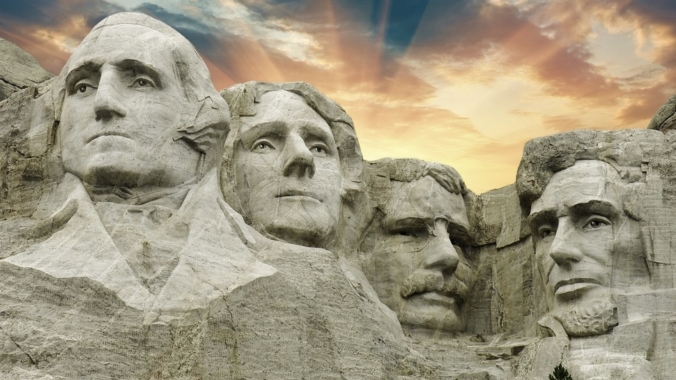South Dakota: Admission as a New State and Its 1889 Constitution
LISTEN ON SOUNDCLOUD:
South Dakota was admitted to the Unites States November 2, 1889 as the fortieth state. In the same year of 1889, the South Dakota State Constitution in use today was adopted.
On March 2, 1861, President Buchanan signed the bill that created the Dakota Territory. Within this territory were included the present states of North and South Dakota, Montana and Wyoming. After creating the Dakota Territory, the federal government paid relatively little attention to it, given the preoccupation with the war. But as soon as there was sufficient population in the territory, the settlers in the Dakota Territory began taking steps to achieve statehood. Starting in 1868, efforts intensified toward the admission of Dakota, either as a single state or two different states.
Even though the Dakota Territory was being settled during the Civil War, South Dakota did not become a state until 1889. This long delay in the pursuit of statehood stemmed from political conflicts at the national level. During the 1880s, for instance, the Democratic Congress opposed statehood for South Dakota, which was seen as a strongly Republican-leaning state. The Democratic Congress resisted admitting a state that was certain to send two more Republicans to the United States Senate. Consequently, the congressional debate on the issue of South Dakota statehood rested largely on a partisan basis.
However, the obstacles to statehood for South Dakota largely disappeared when Benjamin Harrison won the presidential election of 1888, beating Grover Cleveland. President Harrison had been a strong supporter of statehood for South Dakota during his time as senator from Indiana. At the same time, the Republican Party won control of Congress, and the national Republican Party platform of 1888 had stated that South Dakota should be immediately admitted as a new state.
The statehood bill was passed in February of 1889 and authorized the state constitutional convention of 1889, which was to be the first constitutional convention in South Dakota legally recognized by Congress. The resulting constitution was approved by the people at an election held in October. And on November 2, 1889, President Harrison issued his proclamation admitting South Dakota as a state.
Although the 1889 convention produced the Constitution in effect today, it was not the first constitutional convention convened by statehood advocates. The first constitutional convention for South Dakota took place in 1883, even though that convention was not authorized by Congress.
The 1883 constitution reflected the political concerns of the times. South Dakotans sought statehood at a time when railroads and corporate conglomerates played powerful roles on both the state and national scene. Although the railroads greatly contributed to South Dakota’s development and population, they also threatened to corrupt state legal and political processes.
At the 1883 convention, there were concerns that corporations should pay the same rate of taxes as private individuals, should not be allowed to consolidate, and should receive no aid that is not given private parties. The Convention also required the legislature to regulate railroad rates and prohibit unjust rate discrimination. The convention delegates feared that railroads or other large corporations could exercise excessive influence over the legislature.
A second constitutional convention convened on September 8, 1885. This convention has been called the most important ever held in South Dakota, insofar as the constitution produced by that convention, with a few minor changes, became the constitution authorized by Congress and ratified by the voters in 1889.
The South Dakota statehood bill passed by Congress in February of 1889 necessitated a third constitutional convention so as to make the 1885 constitution conform to federal law. By the time the 1889 convention occurred, the Farmers’ Alliance of Dakota Territory was playing a major political role. With declining prices for farm crops and higher production costs, many farmers had fallen deep in debt. For political relief, they turned to the Alliance, which played an influential role in securing the Initiative and Referendum provisions in the Constitution.
Perhaps the most unique feature of the South Dakota Constitution was its provisions on the Initiative and Referendum. South Dakota was the first state in the Union to adopt the Initiative and Referendum, which was later adopted by dozens of other states.
Whereas the Initiative allows the public to bypass the legislature and directly pass new laws in a general election, the Referendum allows the public to repeal a law previously enacted by the legislature. Initiative and Referendum was one of the hallmark causes of the Populist movement of the late nineteenth century.
The Populist movement promoted the Initiative and Referendum as an essential means of achieving economic reforms aimed at controlling the political power of railroads and eastern banks. South Dakota was the first state in the nation to have an active Populist Party, which in 1892 made the Initiative and Referendum a central part of its platform.
The campaign to bring Initiative and Referendum to the Dakota Territory was fueled by the economic events of the time, with Dakota farmers attributing declining commodity prices to the manipulations of railroads and eastern banks, and believing that rural interests would be better able to control those outside entities through the Initiative and Referendum process.
Patrick Garry is professor of law at the University of South Dakota and is the author of Limited Government and the Bill of Rights and The False Promise of Big Government: How Washington Helps the Rich and Hurts the Poor.
Click Here for the next essay.
Click Here for the previous essay.
Click Here to have the NEWEST essay in this study emailed to your inbox every day!
Click Here to view the schedule of topics in our 90 Day Study on Congress.




Join the discussion! Post your comments below.
Your feedback and insights are welcome.Feel free to contribute!